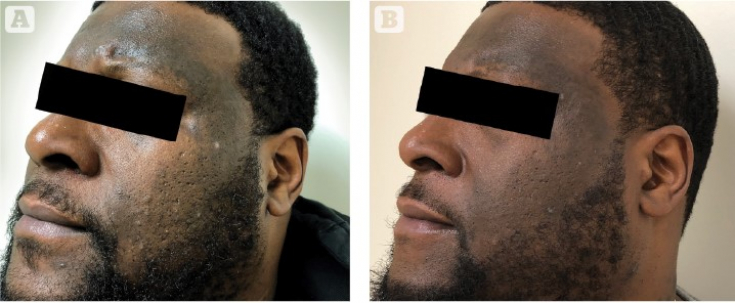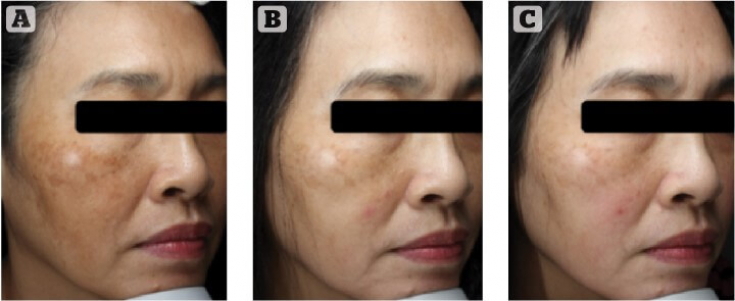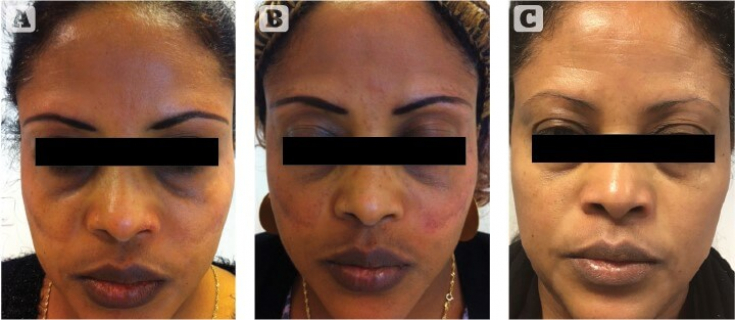Pigmentation disorders still occupy an honorable place in the top of the most frequent complaints that are addressed to a cosmetologist.
The most common – melasma and post-inflammatory pigmentation.
Many skin lightening products available on the market are either ineffective or not safe enough.
Dr. Jennifer David (Jennifer David) in this article estet-portal.com presents a review of cysteamine for the treatment of hyperpigmentation based on efficacy and safety studies of this substance.
- Why is it necessary to treat hyperpigmentation without hydroquinone
- Cysteamine: definition and mechanism of action of a depigmenting agent
- Proven effectiveness of cysteamine for the treatment of hyperpigmentationand
What exactly is the reason for the need to treat hyperpigmentation without the use of hydroquinone
Today, there is an unmet need for an effective and safe treatment for hyperpigmentation.
It is due to the fact that available drugs either do not have a pronounced effect, or are associated with a number of
adverse events, which include:
- exogenous ochronosis;
skin atrophy;
photosensitivity;
post-inflammatory hyperpigmentation;
increased pigmentation.
Topical hydroquinone, banned in Europe, Japan and several other countries due to its low safety profile, is still the gold standard for treating hyperpigmentation in the US.
In search of an alternative to hydroquinone, various substances have been tried that either proved to be toxic or provoked rapid desquamation of the epidermis.
In the 1960s, a molecule was found that does not adversely affect the skin and the human body as a whole, and at the same time effectively suppresses melanogenesis –
Cysteamine – a substance with a proven safety profile that has anti-cancer, anti-carcinogenic and anti-mutagenic effects.Cysteamine: mechanism of action and definition of depigmenting agent
Cysteamine – is the simplest aminothiol that occurs naturally in mammalian cells.
As a degradation product of the essential amino acid L-cysteine, cysteamine is biosynthesized during the coenzyme A metabolism cycle.
Tranexamic acid treatment of melasma: a review of the efficacy of therapy
Cysteamine is evenly distributed in tissues. The highest concentration of this protective antioxidant molecule is found in mammalian milk.

Photo 1: patient with lichen planus pigmentosus (A) before and (B) 8 weeks after treatment with 5% cysteamine (applied once a day for 15 minutes)
Cysteamine – a substance with a proven safety profile that has anti-cancer, anti-carcinogenic and anti-mutagenic effects.
Follow us on Facebook!
The mechanism of action of cysteamine in the skin: the reductant molecule restores the dark oxidized melanin in the stratum corneumof the epidermis to its light form.
Cysteamine has been proven effective in treating hyperpigmentation
The efficacy of topical cysteamine
at 5% concentration for the treatment of hyperpigmentation has been confirmed by a number of studies. So:
1.
In 2013, 30 patients with epidermal melasma were presented at the annual meeting of the American Academy of Dermatology.
Topical cysteamine 5%
(Cyspera, Scientis Pharma) was applied to the skin once a day for 6 weeks.
Significant results were confirmed by dermatoscopy, colorimetry and histological evaluation.

Photo 2:
patient before (A), 8 (B) and 12 (C) weeks after melasma treatment with cysteamine 5% (Cyspera): application once a day for 15 minutes 2.
In 2015, Dr. Mansouri conducted a double-blind, randomized, placebo-controlled study of 50 patients.
After 16 weeks of topical cysteamine 5%:
a 67% decrease in melanin index was documented in melasma (P = 0.0001);
- score by modified area and severity index mMASI showed 58% improvement in melasma symptoms (P = 0.002);
the results of a comprehensive professional assessment indicated moderate or pronounced changes in 100% of cases;
92% of patients noted a reduction in the severity of hyperpigmentation.
- Topical cysteamine 5% has been shown in all studies to be effective in reducing melanin in hard-to-treat pigmented lesions.
Cysteamine is not cytotoxic or photosensitizing, causes fewer adverse events and side effects, and has anti-mutagenic, anti-carcinogenic, and anti-melanoma effects.
A new, yet unpublished
clinical study by Dr.
Karrabi compares the efficacy of a modified Kligman formula and cysteamine 5% (Cyspera). 50 patients with epidermal melasma
.
To assess the effectiveness of therapy, the mMASI scale, a comprehensive professional assessment of investigators, and a patient survey were used.
After 4 months of treatment, it was found that:
Cysteamine 5% over
effectively reduces
- mMASI at 8 and 16 weeks, although the difference is not statistically significant; cysteamine 5% is significantly better tolerated by patients than the Kligman formula.
- Reported cases of therapeutic response to cysteamine in patients with Kligman-resistant melasma
.

Photo 3:
complete therapeutic response to cysteamine 5% (Cyspera) in a patient with hyperpigmentation resistant to Kligman formula: (A) after 4 years of using the modified Kligman formula (Pigmaform) – partial response and signs of skin atrophy as a result of treatment; (B) the patient began to apply Cyspera to the skin for 15 minutes once a day for 4 months; (C) the patient continued treatment with cysteamine 5% for the next 5 years (twice a week for 15 minutes) The obtained results indicate that the effectiveness of cysteamine 5% and the Kligman formula is at least the same.
Topical cysteamine 5% effectively reduces the melanin content in pigmented lesions that are difficult to treat.
At the same time, cystemin is not cytotoxic or photosensitizing, causes fewer adverse events and side effects, and also has antimutagenic, anticarcinogenic and anti-melanoma effects.The high potency of cysteamine, as well as the high safety profile of this brightener compared to the Kligman formula, makes it a promising alternative for the treatment of hyperpigmentation.
Read also
: Melasma treatment: effectiveness of mono- and combination therapies Based on magazine
Prime.







Add a comment